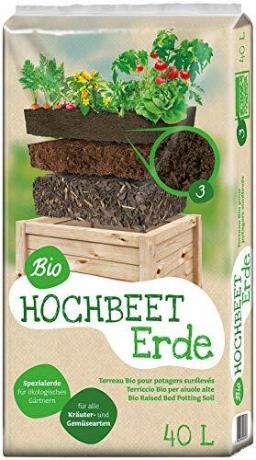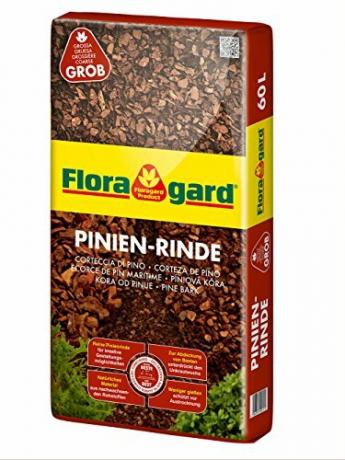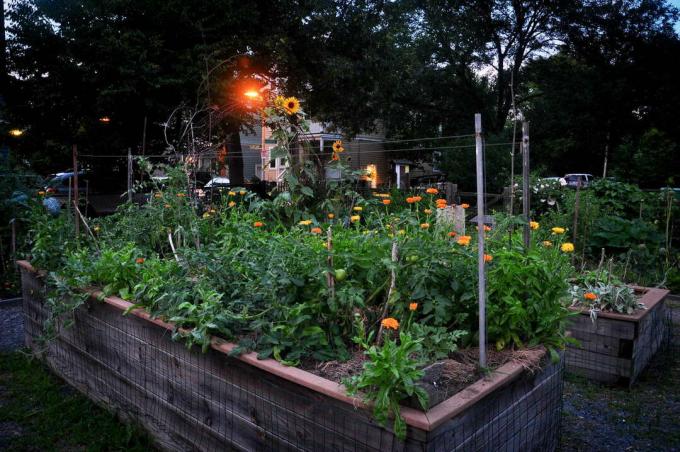Raised beds can now be found in many gardens. But which plants are best suited for growing in raised beds? Learn more here.
Raised beds are trendy. It doesn't matter whether they are made of stone and permanently installed in the garden or made of wood and are mobile and can be placed individually with casters. And this horticultural fad has a clear benefit: warmed by raising the root zone With raised beds, this changes more quickly in summer and so you can achieve higher yields than with cultivation in bed. In winter, however, the unwanted cold gets in faster and can therefore lead to frost damage. But which plants are particularly suitable for growing in raised beds? We will get to the bottom of this question below.
Planting raised beds: making the right choice
In order to achieve good yields in a raised bed, the plants (regardless of whether they are vegetables, herbs or fruit) can be selected according to various criteria. Of course, the growth height of the plants is crucial, because with high-growing crops, care and harvesting can quickly become difficult. In addition, not all plants get along equally well in such a small space and the nutrient requirements of the individual cultures can also be decisive for the selection. So it makes sense to always grow plants with a high nutrient requirement if the last change of the substrate was not too long ago.
In the first year of life of a raised bed, so-called heavy feeders such as money, carrots or strawberries to be grown. A good option for the plant combination in the raised bed is to grow both plants with not so high nutrient requirements and those that require a high supply of nutrients. In addition, a partial change of the substrate in the raised bed - at least in the upper 30 cm - at the beginning of each gardening season in spring is optimal. In addition, some herbs are suitable, such as the aromatic one hyssop or lavender good for cultivation in raised beds, as they can counteract infestation with animal plant pests due to the essential oils they contain.

Criteria for selecting suitable plants
- growth and space requirements
- nutritional needs
- Compatibility with other plants
- Positive effect against pest infestation (herbs)
- hardiness
- Floragard Universal organic raised bed soil: Peat-reduced special soil for ecological gardening in raised beds, the fertilizer Flora Bio-Mix ensures a rich harvest and vital plants.
- Floragard Organic Soil Tasty: Peat-free organic special soil, suitable for tomatoes, courgettes, aubergines and other fruit vegetables.
- Floragard Mulch Pine Bark:Decorative mulch made from pure pine bark, protects plants from frost and cold, naturally suppresses weed growth.

Universal organic raised bed soil 40 liters
12,89€
Details →

Floragard organic soil delicious 3x20 liters - for tomatoes, vegetables, berries and...
20,97€
Details →

Floragard Mulch pine bark 25-40 mm 60 L • coarse • decorative flooring •...
12,99€
Details →
Plants in raised beds: The 10 top plants
From vegetables to herbs to fruit: These 10 plants are particularly suitable for growing in raised beds due to their specific properties. With which plants in combination they get along and make sense, of course, has to be considered elsewhere.
salad
It doesn't matter whether it's lettuce, radicchio, lollo rosso or iceberg: leafy greens are particularly suitable for cultivation in raised beds, as they grow quickly and produce yields quickly. In addition, lettuce does not have a particularly high nutrient requirement and does not leach out the very limited substrate in the raised bed. In addition, lettuce is very compatible with other plants in the raised bed.
zucchini
zucchini have a very sprawling growth and therefore require a lot of space in the bed. When planting in a raised bed, you can place the zucchini plants on the edge so that they hang down the sides. The rapid heating of the soil in the raised bed also promotes the growth of the heat-loving courgettes.

Real hyssop
hyssop is a Mediterranean herb with a particularly high content of essential oils. In this way you can spice up the kitchen, but also keep unwanted pests out of the bed. aphids or snails are driven away by the intense odors, for example, and so you can keep the pressure of certain pests in the raised bed low even without using pesticides.
MediterraneanHerbs
In general, Mediterranean herbs such as rosemary, basil, thyme or lavender be grown in raised beds. In the summer they enjoy the extra warmth. But overwintering the cold-sensitive plants can sometimes be difficult. Just as the earth warms up more quickly in summer, the cold in permafrost temperatures also finds its way into the raised bed more easily in winter.
tip: For an optimal supply of nutrients to the plants in the raised bed, a primarily organic long-term fertilizer such as ours is suitable Plantura organic universal fertilizer outstanding. This gently releases its nutrients to the plants over a period of three months and sustainably stimulates soil activity in your raised bed.
strawberries
strawberries can also be successfully cultivated in raised beds - over several years. Since they also diligently form runners, they are very easy to propagate yourself. A little fun fact: From a botanical point of view, the strawberry is not a berry at all, but a so-called aggregate fruit. A real berry, on the other hand, is the tomato.

onions
They may make you cry when you peel the onion, but they simply cannot be missing in some dishes. It is therefore more than justified that these leeks find a place in the raised bed. They are put into the ground relatively early in the gardening year (March) and only harvested in autumn when the leaves have dried up. Although they take up a lot of space in the raised bed, they also lead to a relatively reliable harvest.
tagetes
In the vernacular, the tagetes also called student flower. At first glance, this ornamental plant doesn't seem to have much use beyond the bright orange or yellow flowers that grace the garden with vigor. However, you can reduce small threadworms, so-called nematodes, which infest various plants and can thus lead to crop failures and reduced vitality. Tagetes secrete poisonous substances to the small worms, which can only be seen under a microscope, and thus ensure their death.
chard
From the chard Although the leaves are used, botanically it is one of the beets and is therefore related to sugar beet, beetroot and the like. Swiss chard must be watered regularly when growing in the bed. However, since only individual leaves are removed during the harvest, it can remain in place throughout the summer and be harvested again and again. This saves the cultivation of new plants and the space in the raised bed is permanently used.
carrots
Of course they are also suitable carrotsto grow in the raised bed. In this case, too, the additional heat in the raised bed helps to shorten the cultivation time and lead to an early harvest. However, care must be taken to ensure that the raised bed is deep enough and offers the carrots enough space to develop the orange-colored turnips that are in the interest of cultivation.
With this top 10, you can too Successfully plant raised beds. In principle, almost all plants are suitable for growing in a raised bed. Depending on why the plant should find a place in the raised bed, you should ask yourself a few questions before making your selection. However, any gaps that appear can always be filled quickly and spontaneity as well as improvisation experience has shown that gardening in raised beds provides additional and unexpected fun sense of achievement.
